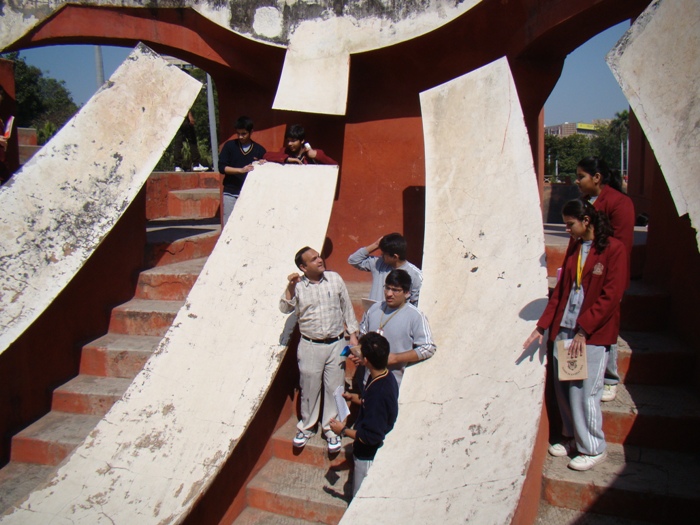Educational Visit to Jantar Mantar
An educational visit to Jantar Mantar was organised by our School on 28 February, 2013 as part of the activities organised for the International Schools Award (ISA), a British Council initiative. This project aims to promote a global spirit among students and monuments in India, the UK and Italy are important elements of this project. The study of these monuments includes all their aspects, namely- historical, scientific and mathematical. As a part of the scientific aspect of the monuments and observatories, 15 students of Class 10 went on this trip. The details of the historical monument Jantar Mantar, which is also an important part of our countrys scientific heritage, were explained to the students in a power point presentation before going over to the monument. Apart from this, they were introduced to monuments in the UK like the Stonehenge and megalithic constructs in the British Isles, at sites like Auglish, Mayan pyramids, Maya sites such as Uxmal and also monuments in Italy like the Pantheon, Messina Cathedral, the Bell Tower, Fontana di Orione ('Fountain of Orion') etc.
At Jantar Mantar, students were made aware of both the historical aspects and the scientific importance of the monument as a tool for the accurate measurement of time and astronomical phenomena, by careful observation of the day and night sky as well as constellations and positions of various celestial bodies in the past. It's name is derived from Yantra or instrument and Mantar or formula, or in this context "calculation". Therefore Jantar Mantar means literally 'calculation instrument'.
[gallery columns="2"]
This observatory has religious significance, since ancient Indian astronomers were also Jyotisa masters. It consists of various architectural astronomical instruments. The site is one of five built by Maharaja Jai Singh II of Jaipur, from 1724 onwards, as he was given by Mughal emperor Muhammad Shah the task of revising the calendar and astronomical tables The primary purpose of the observatory was to compile astronomical tables, and to predict the times and movements of the sun, moon and planets. The students observed all the four Yantras namely - Ram, Jaiprakash, Samrat and Mishra.
As filed by Tapeshwar Sir.
On 28 February, 2013, the students of class 10 visited Jantar Mantar which is an assembly of of 13 architectural astronomy instruments, one of 5 sites built by Maharaja Jai Singh II of Jaipur, from 1724. The Maharaja was given the task of revising the calendar and astronomical tables by the Mughal emperor Muhammad Shah. The primary purpose of the observatory was to compile astronomical tables and to predict the timing and movements of the sun, moon and planets namely the science of modern day astronomy.
The distinctive instruments in the observatory are:
Samrat Yantra: The Samrat Yantra, or Supreme Instrument is a giant triangle that is fundamentally an equal hour sundial. On either side of the triangle is a quadrant with graduations indicating hours, minutes, and seconds.
Jayaprakash Yantra: The Jayaprakash consists of hollowed- out hemispheres with markings on their concave surfaces. Crosswires were stretched between points on their rim. From inside the Ram, an observer could align the position of a star with various markings or even a window's edge.
Ram Yantra which can measure the altitude of sun and stars.
Mishra Yantra: The Mishra yantras were able to indicate when it was noon in various cities all over the world and were the only instruments in the observatory not established by Jai Singh II.
The observatory is built of stone and marble with each structure having an engraved astronomical scale.
It was a very interesting experience and we returned to School armed with a new perspective of our heritage and for our Physics class.
By Shruti Gupta and Bhavya Gupta, class 10 C.
[nggallery id=137]













